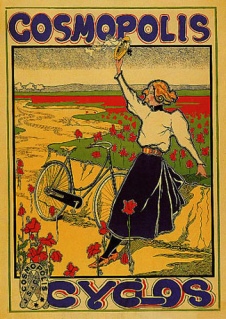“Plants do not have the power of locomotion — except perhaps for kudzu.”
— Anonymous
I guess it seemed like a good idea at the time.
In 1876, a fast-growing vine from Japan made its first appearance in the United States at the Philadelphia Centennial Exposition, the first official U.S. world’s fair to mark the 100th anniversary of the signing of the Declaration of Independence.

Extent of kudzu infestation
The plant, known to botanists as Pueraria lobata and to the rest of us as kudzu, is a climbing, coiling vine native to southern Japan and southeast China. It was promoted at the fair as a forage crop and an ornamental plant.
But apparently its promoters didn’t realize that the southeastern United States, with hot, humid summers, frequent rainfall and mild winters with few hard freezes, was perfect for the proliferation of kudzu, which now has infested between 7,700 and 12,000 square miles of the United States.
Our cross-country bicycle route will take us through kudzu country — from East Texas to Florida.
I haven’t traveled much in the Deep South. So the ubiquity of kudzu was a revelation to me when my wife and I drove from Fort Worth several years ago to Charleston, S.C., and Savannah, Ga., via Louisiana, Mississippi and Alabama.

Kudzu envelops a house
The stuff was everywhere, climbing and enveloping utility poles, abandoned houses, junk cars. A structure overtaken by kudzu is reminiscent of a Mayan temple reclaimed by the jungle.
The U.S. Soil Conservation Service — established in 1935 when severe drought was turning the topsoil of the Great Plains to dust and the wind was blowing it hither and yon — encouraged farmers in the southeastern United States to plant kudzu to reduce soil erosion. The practice continued into the early 1950s.
Now kudzu is an ever-expanding green monster that defies eradication.
But recently, some have seen not a monster, but something more benign: a “Kudzu Jesus.”

Kudzu Jesus in Raleigh, N.C.
The leafy apparition of the Prince of Peace, 30 feet tall, is in Raleigh, N.C., along railroad tracks just off Raleigh’s Boylan Avenue Bridge near downtown.
“He snakes up a utility pole, forming a majestic trunk and a head seemingly bowed in prayer or agony,” wrote Josh Shaffer in an Aug. 19 story in Raleigh’s News & Observer. “A pair of arms appears to spread along the wires in each direction, inviting the world into a leafy embrace.
“From the rear, he looks like Christ the Redeemer, the 100-foot statue overlooking Rio de Janeiro from a pointed mountaintop,” Shaffer wrote.
“If Raleigh were, say, medieval Spain, the Kudzu Jesus would inspire far-flung hordes to march here along CSX tracks and bask in its shade. Leaves of the True Vine would pop up in churches everywhere, or in fancy salad bars. Tears made of sap would fall on the railroad cross-ties.
“But aside from a few jests over a pint at the brewpub, the kudzu so far has drawn no followers.”
Check out the video on kudzu in Tennessee.


























































Interesting.
I don’t know If I said it already but …This blog rocks! I gotta say, that I read a lot of blogs on a daily basis and for the most part, people lack substance but, I just wanted to make a quick comment to say I’m glad I found your blog. Thanks, 🙂
A definite great read..Tony Brown